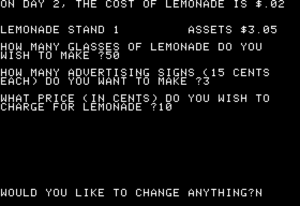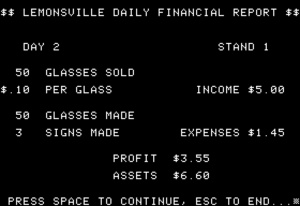Lemonade Stand facts for kids
Quick facts for kids Lemonade Stand |
|
|---|---|
| Developer(s) | Bob Jamison Charlie Kellner (Apple II) |
| Publisher(s) | Minnesota Educational Computing Consortium |
| Platform(s) | Mainframe, Apple II |
| Release date(s) | 1973: Mainframe 1979: Apple II |
| Genre(s) | Business simulation |
| Mode(s) | Single-player |
Lemonade Stand is a fun business simulation game that teaches you about running a small business. It was made in 1973 by Bob Jamison for the Minnesota Educational Computing Consortium (MECC). In this game, you get to run your very own lemonade stand for several days.
Each day, you decide how much lemonade to make, how much to charge, and if you want to advertise. The game then shows you how well you did, based on your choices and some random events. For example, a sudden thunderstorm could affect your sales! The game lasts for 12 days, and at the end of each day, you see a summary of your progress.
In 1979, Charlie Kellner made a version of the game for the Apple II computer. Apple even included Lemonade Stand with their computers for many years. MECC also sold the game as part of software bundles for Apple and Atari 8-bit computers. The game's code was later made available for free, so people could play it on newer computers. Many people, both then and now, think Lemonade Stand is a great way for kids to learn about business and making smart decisions.
Contents
How to Play Lemonade Stand
Lemonade Stand lets you pretend to run a lemonade stand. Your choices about making lemonade, setting prices, and advertising will decide if your business succeeds or fails. The game became popular because it had enough choices to make it interesting, but it was still easy to understand for new players. It was a simple way to learn about running a business.
At the start of each day, you get a weather report. It could be sunny, cloudy, or hot and dry. Each weather type has a different picture. Then, you decide three things:
- How many glasses of lemonade you want to make.
- How many advertising signs you want to put up.
- How much each glass of lemonade will cost.
After you make your choices, the game shows you how much money you earned that day. Sometimes, unexpected things happen. A thunderstorm might appear on a cloudy day, which means you won't make any money and will lose what you spent. Other random events can also occur, like streets being closed or your signs blowing away. The game continues for 12 days.
The Apple II version of the game added music. You might hear parts of "Singin' in the Rain" during thunderstorms or "Raindrops Keep Fallin' on My Head" on cloudy days. "Call to the Dairy Cows" played on sunny days, and "Summertime" played on hot and dry days. This version also added color to the thunderstorm animation.
Game History
Lemonade Stand was first created by Bob Jamison in 1973. He worked for the Minnesota Educational Computing Consortium. The game was originally made for large mainframe computers that many people could use at the same time.
Different Versions of the Game
Charlie Kellner changed the game to work on the Apple II computer in February 1979. Apple then included this version for free with their computers throughout the 1980s.
The Minnesota Educational Computing Consortium also sold Lemonade Stand. It was part of a group of seven Apple II games for kids, costing US$25. MECC also put the game in a package for Atari 8-bit computers.
Another version for Atari 8-bit computers was made by Bob Polaro. It was released in 1981 and was simply called Lemonade.
Legacy of Lemonade Stand
The original code for Charlie Kellner's Apple II version has been available since 1979. Later, the game was updated to work on modern computers like Windows and macOS. It was released as free and open-source software, meaning anyone can use and change it for free.
Similar Games
- Lemonade Tycoon is a more recent game that is similar to Lemonade Stand.



